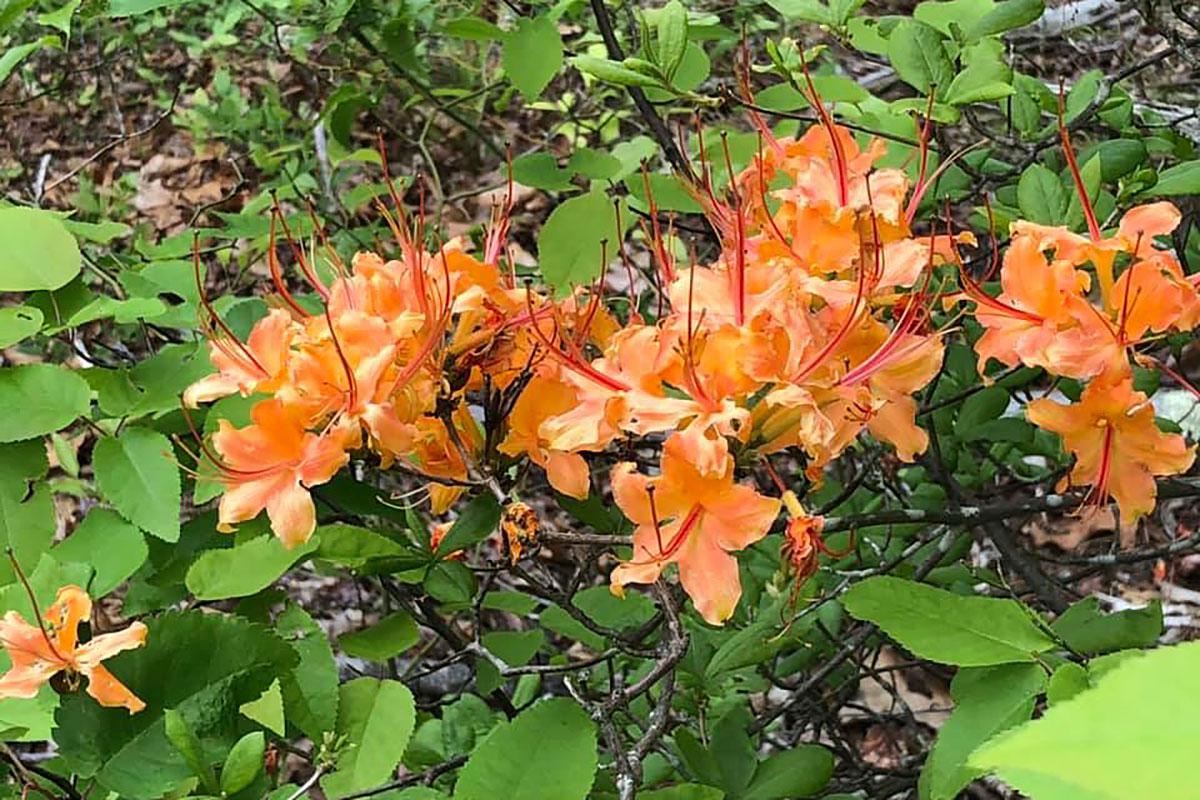
Blog for Zipline Attraction in the Smoky Mountains
Located in Pigeon Forge, TN and near Gatlinburg and Sevierville.
Must-See Wildflowers and Plant Life in the Smoky Mountains
By Ross Bodhi Ogle
Posted on February 4, 2025

The Great Smoky Mountains National Park is a botanical wonderland, home to a staggering variety of wildflowers, trees, and plant life that thrive in the region's rich, diverse ecosystems. From the lush valleys to the high-altitude slopes, the park is a living, breathing testament to nature's beauty. Whether you're a seasoned botanist or simply someone who loves to take in nature's splendor, the wildflowers and plant life in the Smokies will leave you in awe.
Here's a guide to some of the must-see wildflowers and plant life in the Smoky Mountains that you should look for on your next visit.
1. Flame Azaleas (Rhododendron calendulaceum)
Best Time to See: Late Spring to Early Summer
The vibrant flame azaleas are one of the Smoky Mountains' most iconic wildflowers, known for their striking orange, red, and yellow blossoms. These fiery blooms are often found in higher elevations along the park's ridges, where they light up the mountainsides during late spring. Their vibrant colors create a stunning contrast against the rich green backdrop of the Smoky Mountain forests. If you're hiking along trails like the Boulevard Trail or the Alum Cave Trail, keep an eye out for these gorgeous shrubs in bloom.
Fun Fact: The flame azalea is the state flower of Tennessee!
2. Trillium (Trillium spp.)
Best Time to See: Early Spring
Trillium, often referred to as the "flower of the woods," is one of the first signs of spring in the Smokies. These delicate, three-petaled flowers come in a variety of colors, including white, pink, and red, and are commonly found in the shaded, moist woodlands of the lower and middle elevations. The Great Smoky Mountains are home to several species of trillium, including the Large-flowered Trillium and Painted Trillium. You'll typically spot them along trails like the Porter's Creek Trail and Cades Cove during early spring.
Fun Fact: Trillium flowers are often referred to as “wake robins” because they are one of the first flowers to bloom after the last frost.
3. Rhododendron (Rhododendron maximum)
Best Time to See: Late Spring to Early Summer
The rhododendron is another stunning, iconic plant of the Smoky Mountains. These large, bushy shrubs produce clusters of white to lavender-pink flowers, creating striking floral displays in the park's higher elevations during late spring and early summer. The Catawba Rhododendron is a popular variety with its beautiful purple blooms. These vibrant shrubs can be found along trails like the Balsam Mountain Trail and Highland Trail. Keep an eye out for them at Clingmans Dome or along the Roaring Fork Motor Nature Trail, where they add a burst of color to the surrounding greenery.
Fun Fact: The rhododendron's leaves are thick and leathery, which helps it withstand the harsh mountain weather.
4. Bloodroot (Sanguinaria canadensis)
Best Time to See: Early Spring
As one of the first wildflowers to bloom in the spring, bloodroot is a true sign of warmer days ahead in the Smokies. This small, white flower with bright yellow stamens typically blooms in early spring, often before the surrounding trees have fully leafed out. Bloodroot can be found growing in rich, wooded areas along trails like the Middle Prong Trail and Meigs Mountain Trail. Its name comes from the red-orange sap found in its root, which was historically used by Native Americans for medicinal purposes.
Fun Fact: Despite its medicinal uses, bloodroot is toxic if consumed, so be sure to admire its beauty from a safe distance.
5. Mountain Laurel (Kalmia latifolia)
Best Time to See: Late Spring to Early Summer
The mountain laurel is another favorite of Smoky Mountain hikers. Known for its small, pink and white clusters of flowers, mountain laurel thrives in the understory of the Smokies' forests. These shrubs often grow in dense thickets along higher elevation trails, creating a dreamy, ethereal landscape. You can find them in areas like Elkmont and the Alum Cave Bluffs Trail, where their delicate blossoms add a burst of color to the rugged landscape.
Fun Fact: Mountain laurels are not just beautiful-they're also highly toxic. Though they're often admired by wildlife like deer and birds, humans should be careful not to ingest any part of the plant.
6. Wild Geranium (Geranium maculatum)
Best Time to See: Spring to Early Summer
The wild geranium is a lovely perennial that thrives in the Smoky Mountains' woodlands. Its soft pink to purple flowers bloom in early to mid-spring, adding a delicate touch to the forest floor. You'll typically find them along shaded trails such as the Glen Falls Trail or Smokemont Loop. These flowers stand out for their graceful, five-petaled blooms and fern-like leaves, which are characteristic of many woodland wildflowers.
Fun Fact: Wild geraniums are often called “spotted cranesbill” because of the distinctive markings on their leaves.
7. Golden Seal (Hydrastis canadensis)
Best Time to See: Spring
A rare and prized wildflower of the Smokies, golden seal is found in the park's rich, shaded coves and ravines. Its bright yellow root was historically used by Native Americans for medicinal purposes. Golden seal has a small, white flower and distinctive, palmate leaves, and its root is often harvested for use in herbal remedies. While not as visually striking as some other blooms, its unique medicinal history makes it a fascinating plant to look for on your hikes.
Fun Fact: Golden seal is considered a "threatened" plant in the Smokies due to overharvesting, so be sure to leave it undisturbed in the wild.
8. Jack-in-the-Pulpit (Arisaema triphyllum)
Best Time to See: Spring
The Jack-in-the-pulpit is a unique wildflower that can be spotted along the forest floor in moist areas of the Smoky Mountains. Its distinctive flower, shaped like a hooded pulpit (hence the name), is actually a spadix-a tall structure surrounded by a leaf-like hood called a spathe. Jack-in-the-pulpit is often found in damp, shaded areas along trails like Chimney Tops and Newfound Gap Road. Look for it in early spring, when its distinctive green and purple coloring stands out among the forest's new growth.
Fun Fact: While this plant has a striking appearance, all parts of it are toxic if ingested. It's a good example of how nature can be both beautiful and dangerous.
Final Thoughts: A Blooming Adventure
The Great Smoky Mountains National Park offers some of the most diverse and beautiful plant life in the eastern United States, making it an absolute must-visit for nature lovers and wildflower enthusiasts. Whether you're hiking through the lush valleys or exploring the high-elevation trails, you'll encounter a breathtaking array of flowers and plants that bring the landscape to life. Be sure to plan your visit around the blooming seasons to catch these wildflowers in full color, and remember to respect the park's natural beauty by observing all plants from a safe and respectful distance.
So, grab your camera, lace up your hiking boots, and head into the Smokies for a botanical adventure you won't soon forget! And there are plenty of flowers at various times on our canopy tour in the Smokies.

